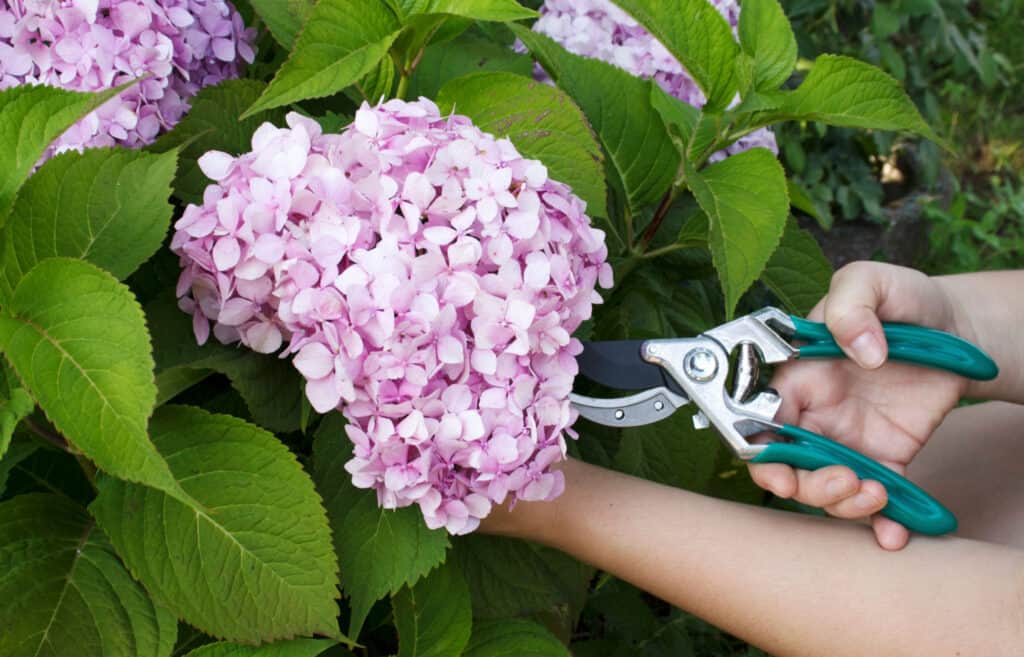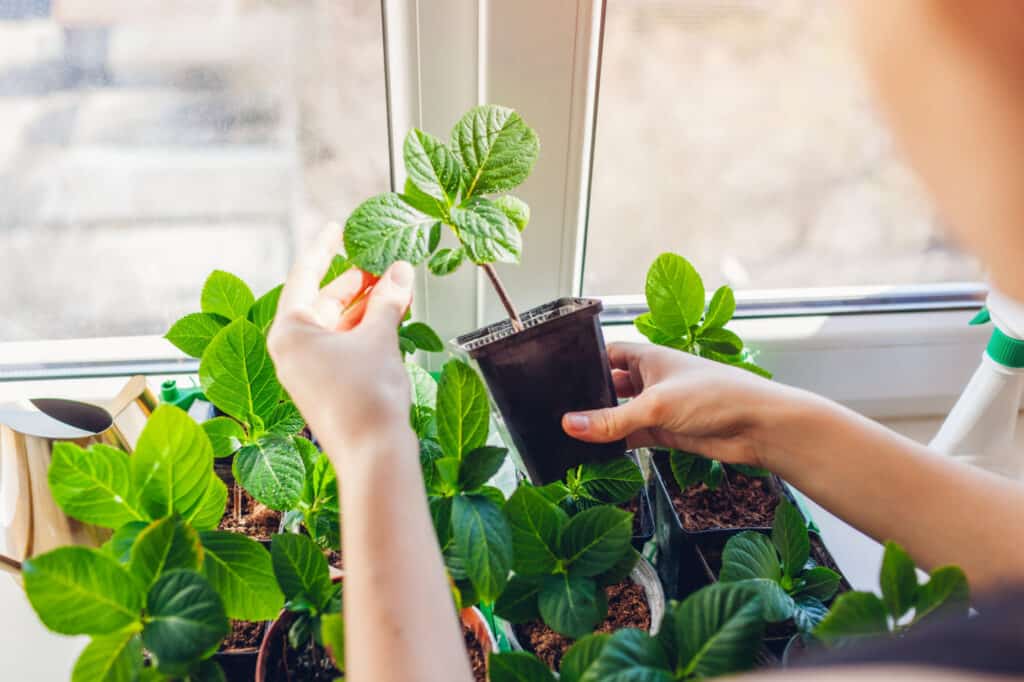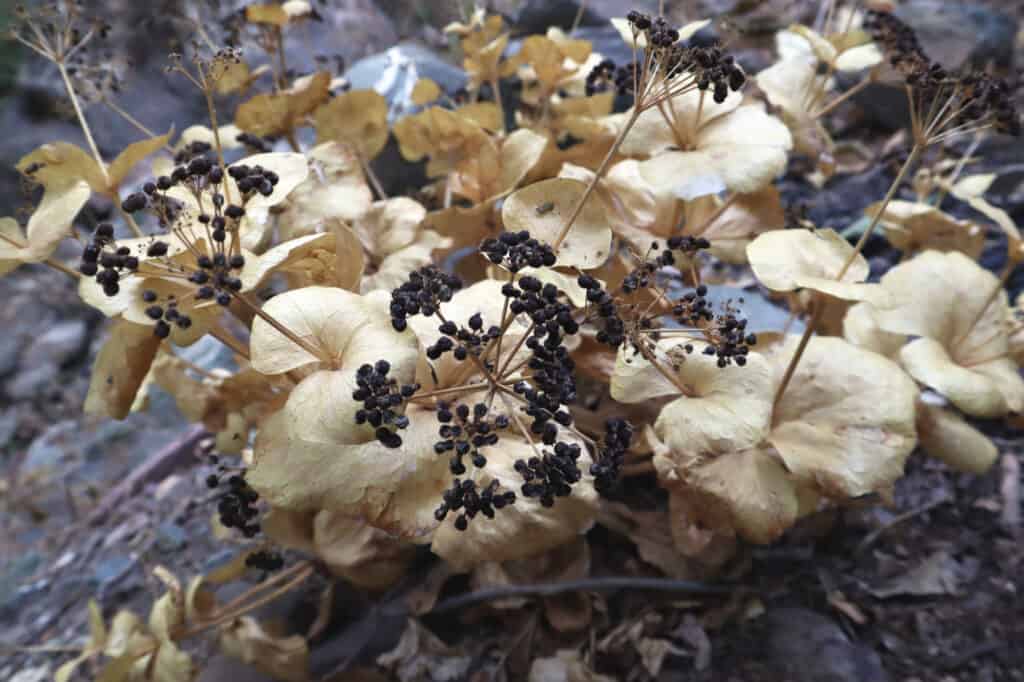Have you ever wondered whether or not you can successfully grow hydrangea seeds? Ornamental and infamous for their blooms, hydrangea plants can be grown from nursery starts, propagated cuttings, or even from seed. But how can you best accomplish this process, and are there any tips and tricks to keep in mind so that you have optimal results?
Hydrangeas are easily grown from seed, so long as you handle the tiny seeds with care! Begin your hydrangea plants indoors, sometime during late winter or early spring. Fill a flat with quality, well-draining soil, and sprinkle the delicate seeds on top. Water well, and keep your seeds moist while they germinate for two weeks. Once seedlings appear, separate and plant in their own pots!
But what types of hydrangeas are there, and can you harvest seeds from your very own hydrangea plants? Let’s dive in and learn all about hydrangea seeds now!

Hydrangeas are easily grown from seed, so long as you handle the tiny seeds with care!
©krolya25/Shutterstock.com
| Hydrangea Seeds | How to Grow |
|---|---|
| Hardiness Zones | 3 through 7 |
| Popular Hydrangea Varieties | Countless cultivars separated into distinct species (Oakleaf, Bigleaf, Smooth, and Panicle) |
| Harvesting Hydrangea Seeds | Remove dried hydrangea flowers during fall; take extra care, given how small these seeds are! |
| Time of Year to Plant Seeds | Germinate indoors in late winter and early spring; plant young hydrangeas outdoors in fall, once they are well-established |
| Things to Note | Hydrangeas don’t grow true to seed or to their parent plants, so expect the unexpected if you grow your own seeds picked from plants! |
Hydrangea Seeds: What Do They Look Like?

If you are harvesting your own hydrangea seeds, it’s recommended that you use a white cloth bag or white piece of paper in order to see what you’re working with!
©Natallia Ustsinava/Shutterstock.com
The trouble with identifying hydrangea seeds is that they are typically too small to properly identify. In fact, most hydrangea seeds are dark in color, and small enough to be mistaken for specks of dirt or dust. If you are harvesting your own hydrangea seeds, it’s recommended that you use a white cloth bag or white piece of paper in order to see what you’re working with!
The good news is, when planting these delicate seeds, all you need to do is scatter them across the surface of your desired soil medium. You don’t need to worry about evenly spacing out these microscopic seeds, and simply letting them set atop some dirt is good enough for the average hydrangea seed!
Popular Hydrangea Species and Cultivars

There are countless hydrangea cultivars, largely separated into four distinct categories.
©SutidaS/Shutterstock.com
Given the fact that hydrangeas do not grow true to seed or to their parent plants, any hydrangea that comes from a seed plucked from a random plant is widely considered its own unique cultivar. You will only get a hydrangea plant that looks like its parent if you purchase seeds from a reputable seed manufacturer. That’s why there are countless varieties, largely separated into four distinct categories. Here are the most popular hydrangea types, as well as some potential cultivars to consider:
- Oakleaf Hydrangeas. These hydrangeas develop flowers that are flat and more spaced out, and their leaves look just like oak leaves! Popular varieties include “Pee Wee” (compact with purple leaves), “Alice” (huge shrub and white flowers), and “Gatsby Moon” (known for its beautiful double blooms).
- Bigleaf Hydrangeas. Iconic in their appearance, bigleaf hydrangeas are among the most popular hydrangea varieties planted around the world. Some famous cultivars to consider include the “Cityline” series (varies in color but flowers are always huge), “Let’s Dance” (delicate blossoms and huge leaves), and “Abracadabra” (dark leaves with bright bright flowers).
- Smooth Hydrangeas. Also known as wild hydrangea, smooth hydrangeas frequently produce huge mopheads of flowers. While most cultivars produce delicate white flowers, you might enjoy the “Incrediball”, “Invincibelle”, and “Annabelle” cultivars. The flowers produced are often the largest of any type of hydrangea variety!
- Panicle Hydrangeas. Unique in the way their flowers form, panicle hydrangeas are among the easiest hydrangea varieties to grow and maintain. They have the most different flowers compared to every other clustered hydrangea variety. Some popular cultivars include “Bobo” (compact with delicate flowers), “Little Lamb” (tiny flowers in huge white clusters), and “Quick Fire” (ideal for vase-cut blooms).
Germinating and Growing Hydrangeas from Seed

While they may be small and difficult to handle, hydrangea seeds will germinate best after being soaked.
©Mariia Boiko/Shutterstock.com
From start to finish, you can grow your own hydrangea shrubs from seed. While propagation and nursery plants also work, growing from seed is extremely rewarding. Here’s how to best accomplish this process:
- Soak your seeds for up to 48 hours before planting. While they may be small and difficult to handle, hydrangea seeds will germinate best after being soaked. Place your seeds between some damp paper towels and make sure they are kept warm and moist for up to 48 hours before your ideal planting day.
- Fill a tray with well-draining soil and seeds. Starting your hydrangeas indoors is recommended given just how easily your seeds can blow away outdoors. Start a flat of soil sometime toward the end of winter or early spring. Sprinkle your delicate hydrangea seeds on top of your soil, and be sure to not bury them. Avoid drafts or winds!
- Water well and keep warm! Seedlings love to stay moist and warm while they grow, and hydrangeas are no exception. While they need roughly two weeks to germinate, keep your seeds in a warm location, perhaps with a plastic dome or wrap over top to promote moisture and humidity.
- Transplant baby hydrangeas into their own containers. Your hydrangea babies won’t be ready to go outside until the end of summer, but now is the perfect time to thin your seedlings and plant all viable options. give them their own containers once they are large enough to handle, and give them plenty of sunlight and water from now until their transplant date!
Harvesting Hydrangea Seeds

By simply shaking the trimmed hydrangea, you can dislodge countless hydrangea seeds into a contained area!
©herdem/Shutterstock.com
Harvesting hydrangea seeds from your own hydrangea plants is easier than you think. Despite their small size, you can gather enough seeds to fuel multiple plants from just a single dried flower! Here’s the best way to harvest:
- Wait until your hydrangea flowers have turned brown. When your flowers are dry and old, watch them carefully. You might be able to see the centers of some flowers going to seed, and now is the time to harvest.
- Place a cloth bag over your desired flower. Whichever flower or flowers look as if they have the most seeds, be sure to capture them in a cloth bag before you cut them. This prevents any potential seeds from getting lost as you trim your hydrangea!
- Cut the dead flowers from the plant. Deadheading your hydrangeas at the end of their growing season is always a good idea, and you can easily snip the seed heads you need into their cloth bag!
- Let the flowers continue to dry. You should leave your flowers in their bag for up to a week, giving the seeds plenty of time to dry out and develop.
- Shake the flower inside the bag. By simply shaking the trimmed hydrangea, you can dislodge countless hydrangea seeds into a contained area! You may need to spend some time separating the seeds from the dried flower sections, but this is best done on a piece of paper or another area where you can properly see the specks of dust that you’re looking for!
Up Next
- Lupine Seeds: Grow This Beautiful Wildflower in Your Own Garden
- Hosta Seeds: How to Plant and Grow This Versatile Beauty
- Cosmos Seeds: Easily Grow This Annual Flower!
The photo featured at the top of this post is © Natallia Ustsinava/Shutterstock.com
Sources
- The inheritance of inflorescence types in Hydrangea macrophylla, Available here: https://www.jstage.jst.go.jp/article/jjshs1/81/3/81_263/_article/-char/ja/
- Several Factors Affecting Seed Germination of Hydrangea petiolaris Siebold & Zucc., Available here: https://www.koreascience.or.kr/article/JAKO201432252666813.page
Thank you for reading! Have some feedback for us? Contact the AZ Animals editorial team.







